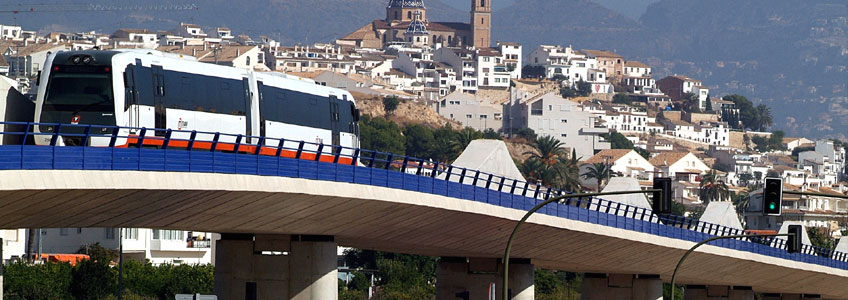The Alicante Metropolitan TRAM passenger transport network started operation from an axis formed by the narrow gauge railway line between the city of Alicante and Denia. The first section of this line was between Alicante and Altea and went into operation in 1914. One year later, in 1915, the stretch extending to Denia was inaugurated.
Originally the line was 93,235-kilometres long. This route’s uneven terrain is worth noting. Especially in the section between Altea and Denia where there are still very steep slopes, 2,5 Kilometres of tunnels, 7 viaducts and 17 metallic bridges which are over 8 metres high.
Originally the line was used to transport goods, especially raisins and wine, typical product from the area. The decline of these crops and the increase in tourism along the Costa Blanca, determined that the line be exclusively destined to the transport of passengers.
1986
In 1986 Ferrocarrils de la Generalitat Valenciana was constituted and on the 1st of January 1987 it started to run operations following a transferral process to the Valencian Community of the services that the narrow gauge railway company (FEVE) had been operating in its territory for the central government.
The Alicante-Denia line was completely run with diesel engines. Its repercussion on urban and inter-regional mobility was limited. Although, thanks to the socio-economic characteristics of the area and to the singular beauty of the route, it possessed notable tourist potential. FGV management increased that potential by launching products aimed at tourism and leisure while maintaining a solid image.
1999
In 1999 a trial run of the Alicante TRAM line went into operation. That first line covered 675 metres between Puerta del Mar and La Marina Station, and another 2.825 metres between La Marina Station and Albufereta, where the TRAM shares rail with the train.
2001

The success of this experience and the excellent response from the citizens of Alicante, encouraged the Infrastructures Regional Ministry to draw up an avant-garde railway project to offer alternatives for public transport in the city of Alicante and its metropolitan area by providing an advanced model for connecting to the Alicante-Benidorm-Altea axis. This is how the Alicante Metropolitan TRAM was born. In December 2001 the first phases of work on this project started.
2003
On August 15th 2003 the first section of the TRAM went into operation between Puerta del Mar de Alicante and El Campello. This makes Alicante the fifth metropolitan area in Spain, after Madrid, Barcelona, Bilbao and Valencia to have a modern, high-capacity, urban transport system.
2007

On the 29th of March 2007 the new workshops and depot for the TRAM were inaugurated in El Campello.
On the 10th of May 2007 the new TRAM service between the La isleta stop and the Market station went into operation. This lead the way for the execution of the project that made the extension of railway services to the centre of the city of Alicante possible through the new underground stations: Mercado and MARQ. One month later, on the 15th of June 2007, the first branch at Cabo de las Huertas, corresponding to Line 4, went into operation. It provided service to the new beach area with Bombardier Trams.
 On the 30th of July 2007, the section between the Market and la Creueta stations went into operation. This section provides a connection between Alicante and La Vila Joiosa with no need for changeovers. To be able to cover this route with semi-direct service in little over 40 minutes, new train-tram units are introduced. (Also called high-speed Trams). These units can circulate on rails in urban areas and reach speeds of up to 100 Kilometres per hour in interurban areas.
On the 30th of July 2007, the section between the Market and la Creueta stations went into operation. This section provides a connection between Alicante and La Vila Joiosa with no need for changeovers. To be able to cover this route with semi-direct service in little over 40 minutes, new train-tram units are introduced. (Also called high-speed Trams). These units can circulate on rails in urban areas and reach speeds of up to 100 Kilometres per hour in interurban areas.
2008

On the 2nd of June 2008, the Line 1 TRAM service was extended to Benidorm. This new service meant that the changeovers from Line 9 that had up until this moment taken place at the Creueta station, could now take place at the Benidorm station. The extension will also allow increasing train frequency and connecting Mercado and Benidorm every 30 minutes.
Alicante is the first city in Spain to have the combined Train-Tram system.
2009

In December 2009 the extension of Tram Line 4 is put into service. It has 6 new stops on Line 4 and services the Albufereta, Cabo de las Huertas and Playa de San Juan areas which have a population close to 40.000 people that increases notably during the summer months and holiday seasons.
2010

On the 18th of June 2010 the Luceros station is inaugurated and becomes the network’s central hub. The new station is 2.200 square metres and has the most advanced accessibility equipment. It connects the centre of Alicante directly to the San Juan beach with no need for changeovers (Line 4) and with El Campello, Villajoyosa and Benidorm.
2013

On September 4th Línea 2 Luceros-Sant Vicent del Raspeig starts offering service. It is 9 kilometres long and has 14 stops (three of them, Luceros, Mercado and Marq are also on lines 1, 3 and 4) that connect the city centre with important areas on the outskirts as it crosses some neighbourhoods such as el Pla, Garbinet, Sagrada Familia, Virgen del Remedio and Virgen del Carmen.
It also connects the heart of Alicante with significant mobility hubs such as the hospital or university and allow for faster and more comfortable links to the capital city and San Vicent del Raspeig.
Due to the restructuring of existing TRAM lines, as of the 1st of July the Puerta del Mar-Sangueta stop on line 4 will be eliminated.
2019

On June 10, Line 5 was launched between Porta del Mar and Plaza La Coruña, which takes advantage of the majority of the route of Line 4 (Luceros-Plaza La Coruña) with fifteen common stations, in addition to two of its own, Porta del Mar and La Marina of the old 4L shuttle that stopped serving in 2013 between Porta del Mar and Sangueta.
This new tram connection between the city of Alicante and the area of Playa de San Juan is possible thanks to the completion of the works of the Serra Grossa tunnel that allows double-lane traffic, in a section that acted as a bottleneck and that prevented introducing more trams to circulation.
2023

On 16 January, the Line 9 section of the TRAM d’Alacant (Benidorm-Dénia) between Gata de Gorgos and Dénia came into service, completing the modernisation process of this line.
In recent years, different actions have been completed, notably the renewal of the track and infrastructure between Altea and Dénia, financed in part with contributions from the European Union.
Technical improvements and new infrastructures, as well as the incorporation of new rolling stock, make it possible to maintain and improve operating conditions, guaranteeing the regularity and quality of the service with similar standards to the rest of the FGV network in Alicante.
The new dual trains (electric and diesel) manufactured by Stadler Rail Valencia have been incorporated for the Line 9 service



